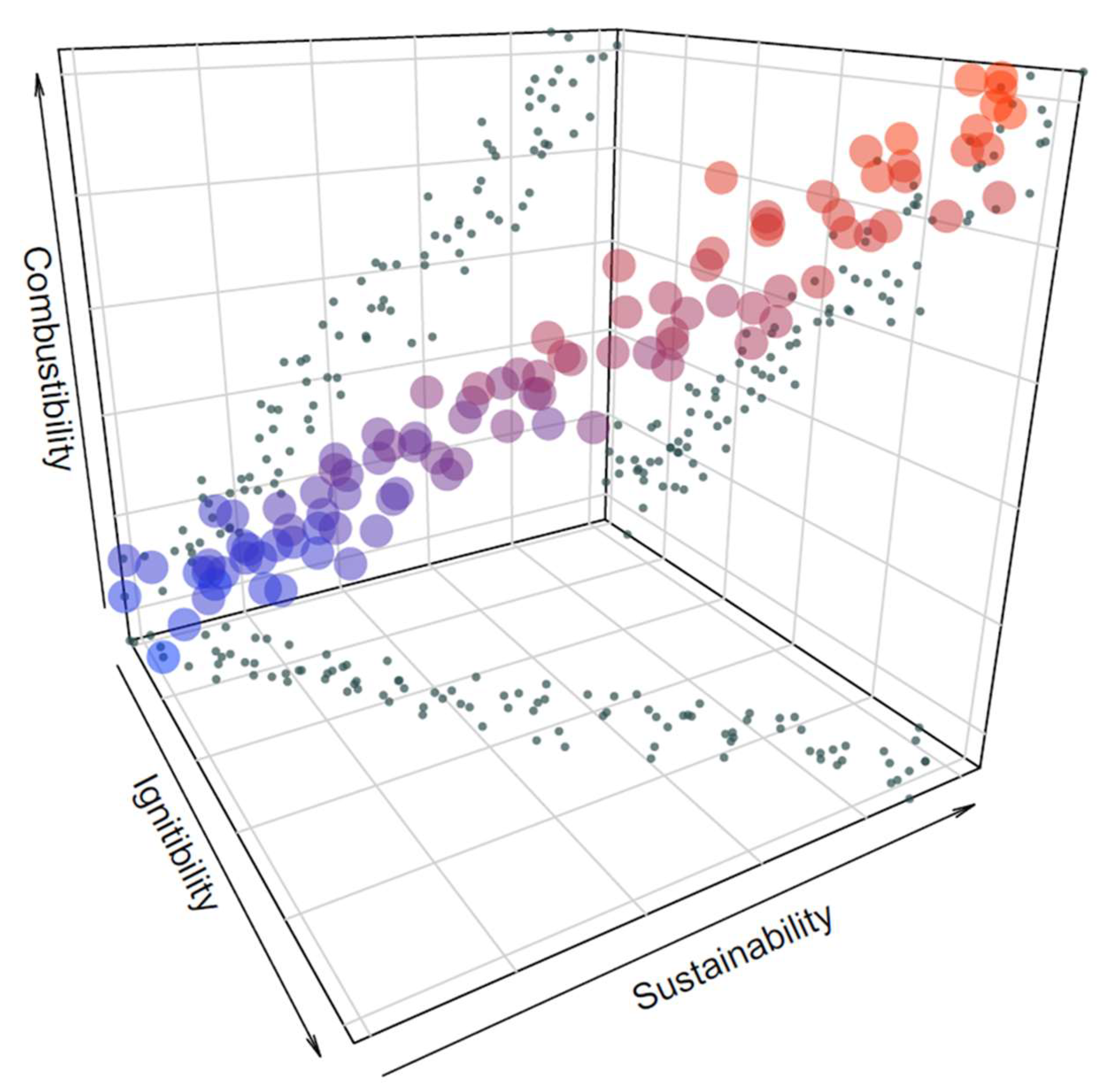An Integrated Approach to Identify Low-Flammability Plant Species for Green Firebreaks
Abstract
Author Contributions
Funding
Acknowledgments
Conflicts of Interest
References
- Nolan, R.H.; Boer, M.M.; Collins, L.; de Dios, V.R.; Clarke, H.; Jenkins, M.; Kenny, B.; Bradstock, R.A. Causes and consequences of eastern Australia’s 2019–20 season of mega-fires. Glob. Chang. Biol. 2020. [Google Scholar] [CrossRef] [PubMed]
- Pickrell, J. Australia’s vulnerable species hit hard by fires. Science 2019, 366, 1427–1428. [Google Scholar] [CrossRef] [PubMed]
- Phillips, N.; Nogrady, B. The race to decipher how climate change influenced Australia’s record fires. Nature 2020, 577, 610–612. [Google Scholar] [CrossRef] [PubMed]
- Moritz, M.A.; Batllori, E.; Bradstock, R.A.; Gill, A.M.; Handmer, J.; Hessburg, P.F.; Leonard, J.; McCaffrey, S.; Odion, D.C.; Schoennagel, T.; et al. Learning to coexist with wildfire. Nature 2014, 515, 58–66. [Google Scholar] [CrossRef] [PubMed]
- Michael, Y.; Lensky, I.; Brenner, S.; Tchetchik, A.; Tessler, N.; Helman, D. Economic assessment of fire damage to urban forest in the wildland–urban interface using planet satellites constellation images. Remote Sens. 2018, 10, 1479. [Google Scholar] [CrossRef]
- Curran, T.J.; Perry, G.L.W.; Wyse, S.V.; Alam, M.A. Managing fire and biodiversity in the wildland-urban interface: A role for green firebreaks. Fire 2018, 1, 3. [Google Scholar] [CrossRef]
- Murray, B.R.; Martin, L.J.; Brown, C.; Krix, D.W.; Phillips, M.L. Selecting low-flammability plants as green firebreaks within sustainable urban garden design. Fire 2018, 1, 15. [Google Scholar] [CrossRef]
- Cui, X.; Alam, M.A.; Perry, G.L.W.; Paterson, A.M.; Wyse, S.V.; Curran, T.J. Green firebreaks as a management tool for wildfires: Lessons from China. J. Environ. Manag. 2019, 233, 329–336. [Google Scholar] [CrossRef] [PubMed]
- Ozbreed. Fire Retardant Plants: Literature Review and Plant List. Available online: https://www.ozbreed.com.au/download/fire_retardant_plants.pdf (accessed on 9 March 2020).
- TFS. Fire Retardant Garden Plants for the Urban Fringe and Rural Areas. Tasmania Fire Service. Available online: https://www.fire.tas.gov.au/publications/1709%20Brochure.pdf (accessed on 9 March 2020).
- Pérez-Harguindeguy, N.; Díaz, S.; Garnier, E.; Lavorel, S.; Poorter, H.; Jaureguiberry, P.; Bret-Harte, M.S.; Cornwell, W.K.; Craine, J.M.; Gurvich, D.E.; et al. New handbook for standardised measurement of plant functional traits worldwide. Aust. J. Bot. 2013, 61, 167–234. [Google Scholar] [CrossRef]
- Anderson, H.E. Forest fuel ignitibility. Fire Technol. 1970, 6, 312–319. [Google Scholar] [CrossRef]
- Murray, B.R.; Hardstaff, L.K.; Phillips, M.L. Differences in leaf flammability, leaf traits and flammability-trait relationships between native and exotic plant species of dry sclerophyll forest. PLoS ONE 2013, 8, 79205. [Google Scholar] [CrossRef] [PubMed]
- Alam, M.A.; Wyse, S.V.; Buckley, H.L.; Perry, G.L.W.; Sullivan, J.J.; Mason, N.W.H.; Buxton, R.; Richardson, S.J.; Curran, T.J. Shoot flammability is decoupled from leaf flammability, but controlled by leaf functional traits. J. Ecol. 2020, 108, 641–653. [Google Scholar] [CrossRef]
- Gill, A.M.; Zylstra, P. Flammability of Australian forests. Aust. For. 2005, 68, 87–93. [Google Scholar] [CrossRef]
- Schwilk, D.W. Dimensions of plant flammability. New Phytol. 2015, 206, 486–488. [Google Scholar] [CrossRef] [PubMed]
- Sharma, S.; Ochsner, T.E.; Twidwell, D.; Carlson, J.D.; Krueger, E.S.; Engle, D.M.; Fuhlendorf, S.D. Nondestructive estimation of standing crop and fuel moisture content in Tallgrass Prairie. Rangel. Ecol. Manag. 2018, 71, 356–362. [Google Scholar] [CrossRef]
- Wyse, S.V.; Perry, G.L.W.; Curran, T.J. Shoot-level flammability of species mixtures is driven by the most flammable species: Implications for vegetation-fire feedbacks favouring invasive species. Ecosystems 2018, 21, 886–900. [Google Scholar] [CrossRef]
- Krix, D.W.; Phillips, M.L.; Murray, B.R. Relationships among leaf flammability attributes and identifying low-leaf-flammability species at the wildland-urban interface. Int. J. Wildland Fire 2019, 28, 295–307. [Google Scholar] [CrossRef]
- Jaureguiberry, P.; Bertone, G.; Diaz, S. Device for the standard measurement of shoot flammability in the field. Austral Ecol. 2011, 36, 821–829. [Google Scholar] [CrossRef]

© 2020 by the authors. Licensee MDPI, Basel, Switzerland. This article is an open access article distributed under the terms and conditions of the Creative Commons Attribution (CC BY) license (http://creativecommons.org/licenses/by/4.0/).
Share and Cite
Murray, B.R.; Brown, C.; Murray, M.L.; Krix, D.W.; Martin, L.J.; Hawthorne, T.; Wallace, M.I.; Potvin, S.A.; Webb, J.K. An Integrated Approach to Identify Low-Flammability Plant Species for Green Firebreaks. Fire 2020, 3, 9. https://doi.org/10.3390/fire3020009
Murray BR, Brown C, Murray ML, Krix DW, Martin LJ, Hawthorne T, Wallace MI, Potvin SA, Webb JK. An Integrated Approach to Identify Low-Flammability Plant Species for Green Firebreaks. Fire. 2020; 3(2):9. https://doi.org/10.3390/fire3020009
Chicago/Turabian StyleMurray, Brad R., Colin Brown, Megan L. Murray, Daniel W. Krix, Leigh J. Martin, Thomas Hawthorne, Molly I. Wallace, Summer A. Potvin, and Jonathan K. Webb. 2020. "An Integrated Approach to Identify Low-Flammability Plant Species for Green Firebreaks" Fire 3, no. 2: 9. https://doi.org/10.3390/fire3020009
APA StyleMurray, B. R., Brown, C., Murray, M. L., Krix, D. W., Martin, L. J., Hawthorne, T., Wallace, M. I., Potvin, S. A., & Webb, J. K. (2020). An Integrated Approach to Identify Low-Flammability Plant Species for Green Firebreaks. Fire, 3(2), 9. https://doi.org/10.3390/fire3020009






